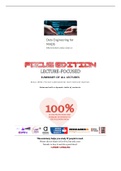Summary
Lecture Summary for Data Engineering for MADS
- Course
- Institution
- Book
The best summary of ALL LECTURES for Data Engineering for MADS (EBM213A05). Enhanced with a dynamic table of contents and meticulous organization for readability and easy studying. 100% of profit from this summary is donated to local Groningen NGOs, as well as national ones.
[Show more]




